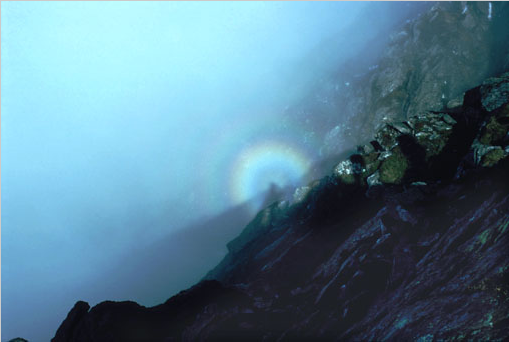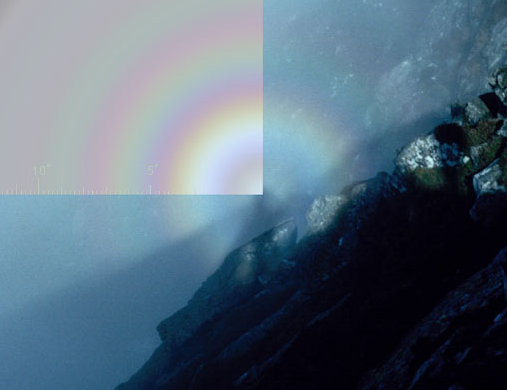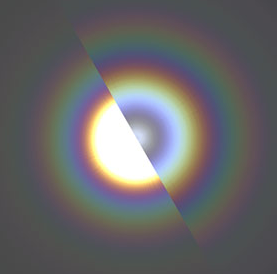Glory Features
Glory Features: Exploring the Spectacular Phenomenon
Glories, a captivating atmospheric optical phenomenon, never fail to amaze with their ethereal beauty. Centered at the antisolar point, directly opposite the sun, glories are typically hidden below the horizon except during sunrise and sunset. These mesmerizing displays can be observed when mist or cloud lies beneath you and sunlight breaks through to illuminate it. From mountains and hillsides to aircraft and sea fog, glories can be witnessed in various settings, even indoors.
Glories owe their existence to the backward scattering of light by individual water droplets. Unlike the corona's aureole, the center of a glory is not as bright. However, its rings exhibit delicate colors reminiscent of the corona's, ranging from blue on the inside to green, red, and purple on the outside. Interestingly, the intensities of these rings diminish more slowly than those of the corona, sometimes revealing three or even four visible rings.
One fascinating aspect of glories is that they are almost always accompanied by shadows that converge on the antisolar point. When your shadow or that of an aircraft you are in is distorted by perspective, it creates a mesmerizing phenomenon known as a "Brocken spectre." This grotesque distortion adds an extra layer of intrigue to the already captivating glory display.
While glories are a remarkable sight on their own, there are other optical phenomena that can be observed at the antisolar point. The heiligenschein and opposition effect are two such phenomena. However, they lack the shimmering rings that make glories truly stand out.
Understanding and predicting glories is made possible through Mie scattering calculations. Tools like IRIS enable scientists to simulate and predict the appearance of glories based on droplet size. By analyzing these simulations, researchers have discovered that glories can be formed by relatively small water droplets, typically around 10 microns in diameter.
In conclusion, glories are a captivating atmospheric optical phenomenon that can be observed in various settings. Their delicate, colored rings and the accompanying shadows add to their mesmerizing beauty. By studying and simulating these phenomena, scientists have gained a deeper understanding of the factors that contribute to the formation of glories. So, keep an eye out for mist or cloud beneath you and the sun breaking through, as you might just witness the enchanting spectacle of a glory.

__Glory on Pinnacle Ridge, Pen yr Ole Wen, Wales____photographed by John Hardwick in February 1993. It shows the classical appearance of a mountain glory as sunshine breaks through a mist. When the mist is nearby the glory is accompanied by your shadow. Larger image. ©John Hardwick, reproduced with permission.
Glories are always directly opposite the sun, centered at the antisolar point and therefore below the horizon except at sunrise and sunset.
Look for them whenever mist or cloud is beneath you and the sun breaks through to shine on it.
Glories can be seen on mountains and hillsides, from aircraft and in sea fog and even indoors.
They are formed when light is scattered backwards by individual water droplets.
They have a bright centre but not nearly as bright as the corona's aureole. Their rings are delicately coloured like those of the corona's, blue on the inside changing through greens to red and purple outside. The ring intensities fall off much more slowly than those of the corona and sometimes three or even four rings are visible.
Shadows converge on the antisolar point and so glories are nearly always accompanied by your shadow or that of the aircraft you are in. When the shadow is grotesquely distorted by perspective it is called a "Brocken spectre".
There are other glows at the antisolar point, the heiligenschein and the opposition effect but these do not have the glory's shimmering rings.

_Glories can be predicted by Mie scattering calculations as used in IRIS. The matching simulation at upper left shows that the droplets were small, only 10 micron diameter. _

Glory (right) and corona (left) for 20µm dia. droplets - IRIS simulations.
Note: this article has been automatically converted from the old site and may not appear as intended. You can find the original article here.
Reference Atmospheric Optics
If you use any of the definitions, information, or data presented on Atmospheric Optics, please copy the link or reference below to properly credit us as the reference source. Thank you!
-
<a href="https://atoptics.co.uk/blog/glory-features/">Glory Features</a>
-
"Glory Features". Atmospheric Optics. Accessed on April 26, 2024. https://atoptics.co.uk/blog/glory-features/.
-
"Glory Features". Atmospheric Optics, https://atoptics.co.uk/blog/glory-features/. Accessed 26 April, 2024
-
Glory Features. Atmospheric Optics. Retrieved from https://atoptics.co.uk/blog/glory-features/.